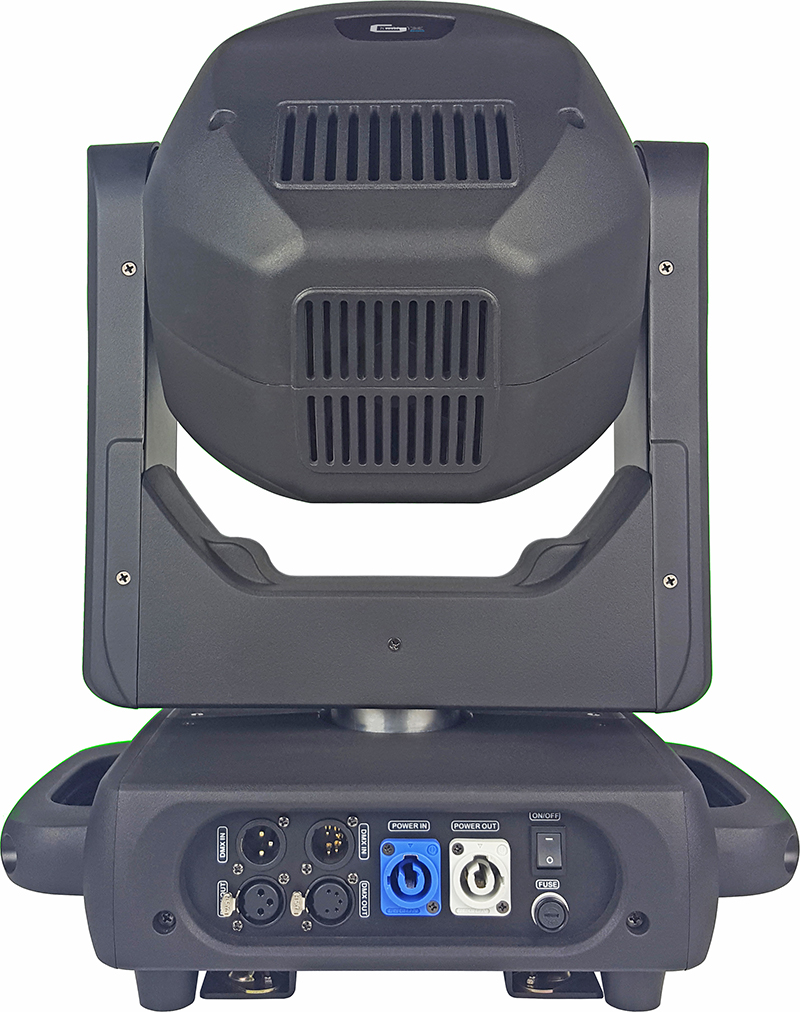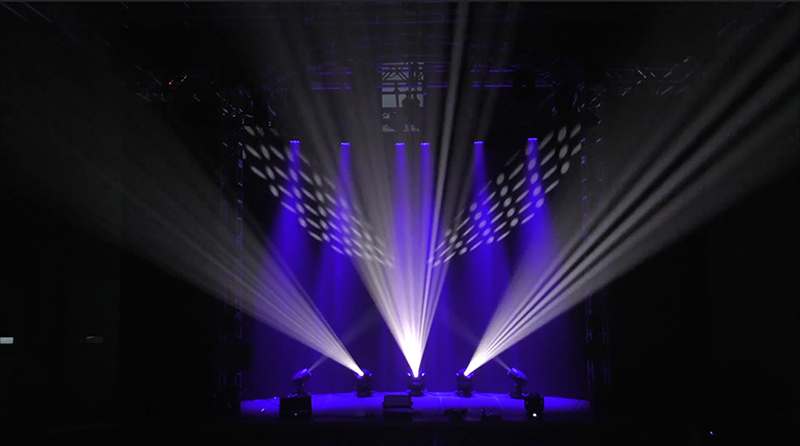
A highlight (pun fully intended) of the LED revolution has been a flattening, if you will, of feature sets between lights intended for the largest productions and smaller, more inexpensive luminaires intended for use in smaller spaces. Freed from (some of) the constraints of thermal and power management, and therefore size, that arc lamps require, today’s smaller fixtures can squeeze many effects into a smaller package. The design of every fixture involves trade-offs; not all features will be available in every light. But today, even quite compact luminaires can boast effects that weren’t found in similarly sized fixtures a few generations ago. Today, we’re examining one such fixture from Wisconsin-based Blizzard Lighting—the G-Max™ 200 spot.
Blizzard’s G-Max 200 spot is a compact moving head fixture, which uses a 200W cool white LED array as its source. I measured an initial output of 6,200 lux at 50% zoom from five meters, and after letting the fixture come to thermal equilibrium for 20 minutes, that figure had only decreased to 6,022 lux which represents a ~3% drop, which is pretty good. While replaceable, the LED engine from LumiEngin is intended to be replaced by a qualified technician, and not something that should be done in the field by an end user. The manufacturer states that the LED engine should be at 90% brightness at 50,000 hours, and at around 60,000, about 85% brightness. The electronic dimming was reasonably smooth, with only some slight steppiness at the very bottom end of the range. I measured the native color temperature of the light out of the front lens at 8,200K, which interestingly is much higher than the 6,500K specified by the manufacturer, and my light meter’s reading confirms what my eyes were telling me. The CTO filter dropped this to 3,580K. At only 283W maximum draw, users can chain several together on a circuit, making cabling easier.

Full Featured
The G-Max 200 comes with a static color wheel with eight colors plus open, including the aforementioned CTO filter. Colors are glued into place and not intended to be swapped out by the user. They proceed around the wheel in (mostly) rainbow order, starting with red, and adjacent filters have no visible gaps between them. This makes for very usable split colors, and indeed, the fixture software allows for not only snaps between colors, but for smooth indexing as well. I’m very pleased to see this feature; many lights I’ve seen at this price point don’t bother allowing you to smoothly index your colors, which deprives you of half the utility of a color wheel—split colors and smooth effects between filters. The colors are all relatively desaturated, likely to get the maximum amount of light from the engine.
The fixture includes quite a lot of gobos for a luminaire of this size: a stamped wheel with seven static gobos plus open, and a rotating wheel with seven glass gobos plus open. Both the stamped and rotating gobos seem to me to be optimized for aerial projection rather than pattern projection onto scenery, and each gobo wheel is fully indexable and has adjustable shake and wheel spin effects. Interestingly, Blizzard has chosen to go with colored gobos for some of the rotating ones [three of the seven]. Whether you find this agreeable or not is up to personal preference, but either way it’s something to be aware of. If you need to swap a gobo out, they all ride in the familiar carriage system, where the gobo and its holder pop out together for easy replacement. Gobo focus was good throughout the zoom range, with minimal chromatic aberration.

Optics
Further down the light train are two prisms and a wash filter. One prism is a six-facet linear prism, and an eight-facet pyramidal octagonal prism. Each prism is fully indexable and rotatable, and each displays good image separation. The eight-facet prism in conjunction with the “flower” rotating gobo produced a particularly trippy effect. The prisms can only be selected one at a time; there is no ability to overlay them. There’s also a mechanical iris included in the effects section for beam reduction effects.
Blizzard has included a non-variable frost with this fixture, which is quite heavy and doesn’t leave any gobo edges intact. It’s intended to be used more as a wash effect, spreading the light, and softening the edges completely, but at the expense of output.
Zoom ranges from 13° to 27°. The zoom is not particularly fast, but it does provide some beam control not usually seen on lights of this size, and insertion and removal are quick enough to be used as an effect. One restriction to be aware of in your programming is that the prisms restrict part of the narrow range of the zoom, so if you have them in, the zoom lenses will move toward the wide part of their range. Pan and tilt ranges are 540° to 230°, respectively. Pan covers a full-range motion in ~2.43 seconds, with tilt taking ~1.2 seconds.
A full reset from a cold start takes 0:55, and fixture reset is badly-behaved in that the light starts outputting before all the electromechanical effects are done homing. This results in incorrect colors and spinning gobos being output before the fixture comes to its correct positioning and output parameters.
The G-Max 200 spot weighs 35.1 lbs. and stands 21.7” tall with a base 14.96” wide by 9.8” deep. Power input and pass-through is via two Neutrik® powerCON™ TRUE1-style connectors, while data input is via both three-pin and five-pin XLR ins and pass-throughs.
At a Glance:
Compact, but Feature Packed
The G-Max 200 spot fills an interesting niche role—a small but capable fixture for smaller touring, house of worship, or production spaces that need a wide variety of effects at an economical price. You won’t find a zoom, iris, and two prisms on many other fixtures at this price point on the market.
G-Max 200 Spot
PROS: Small, compact, minimal power consumption
CONS: Very high native color temperature; might not match other fixtures
FEATURES
- Source: 200W White LED array
- Power Input: Neutrik powerCON TRUE1-style ins and pass-throughs
- Power Draw: 283W at Full
- Data Input: Three-pin and five-pin XLR ins and pass-throughs
- Dimming: Fully electronic
- Color: Static, eight colors plus open, indexable and rotatable
- Gobos: Eight static plus open, Eight rotating (indexable and rotatable) plus open
- Other Effects: Two prisms, iris, non-variable frost, zoom, focus
- Weight: 35.1 lbs.
- Dimensions: 21.7” H, with a base 14.96” W x 9.8” D
Manufacturer: Blizzard Lighting
More Info: www.blizzardpro.com


